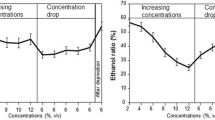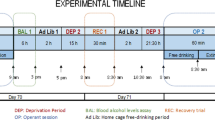Abstract
Anxiolytic effects of ethanol have been proposed to be important factors in the initiation of ethanol consumption. To examine this hypothesis, drug-naive Wistar rats were tested in the elevated plusmaze to determine their initial level of anxiety. Based on their response, we separated the animals into anxious and non-anxious groups. After that, animals went through an oral ethanol self-administration procedure. Rats that were initially classified as anxious showed a significantly (P<0.01) higher intake and preference for ethanol during the initiation phase of the voluntary drinking procedure than non-anxious animals. In another experiment, intraperitoneal (IP) injections of ethanol (0.5–1.5 g/kg) produced dose-dependent anxiolytic effects in rats when tested in the elevated plus-maze procedure. Blood ethanol levels following IP injections during the plus-maze test were similar to those reached during the oral ethanol self-administration procedure, which shows that the rats indeed drank sufficient amounts of ethanol to experience its anxiolytic effects. These findings indicate that the basal level of anxiety plays an important role in vulnerability to alcohol drinking.
Similar content being viewed by others
References
Bibb J, Chambless DL (1986) Alcohol use and abuse among diagnosed agoraphobics. Behav Res Ther 24:49–58
Bozarth MA (1990) Evidence for the rewarding effects of ethanol using the conditioned place preference method. Pharmacol Biochem Behav 35:485–487
Caplan MA, Puglisi K (1986) Stress and conflict conditions leading to and maintaining voluntary alcohol consumption in rats. Pharmacol Biochem Behav 24:271–280
Cappell H, Herman CP (1972) Alcohol and tension reduction: a review. Q J Stud Alcohol 33:33–64
Cicero TJ (1980) Alcohol self-administration, tolerance and with-drawal in humans and animals: theoretical and methodological issues. In: Rigter H, Crabbe JC (eds) Alcohol tolerance and dependence. Elsevier, Amsterdam, pp 1–51
File SE, Zangrossi H, Sanders FL, Mabbutt PS (1994) Raised corticosterone in the rat after exposure to the elevated plus-maze. Psychopharmacology 113:543–546
George DT, Nutt DJ, Dwyer BA, Linnoila M (1990) Alcoholism and panic disorder: is the comorbidity more than coincidence? Acta Psychiatr Scand 81:97–107
Handley SE, McBlane JW (1993) An assessment of the elevated X-maze for studying anxiety and anxiety-modulating drugs. J Pharmacol Toxicol Methods 29:129–138
Kushner MG, Sher KJ, Beitman BD (1990) The relation between alcohol problems and the anxiety disorders. Am J Psychiatry 147:685–695
Meisch RA, Lemaire GA (1993) Drug self-administration. In: Van Haaren F (ed). Methods in behavioural pharmacology. Elsevier, Amsterdam, pp 257–300
Otto MW, Pollak MH, Sachs GS, O'Neil CA, Rosenbaum JF (1992) Alcohol dependence in panic disorder patients. J Psychiatr Res 26:29–38
Päivärinta P, Korpi ER (1993) Voluntary ethanol drinking increases locomotor activity in alcohol-preferring AA rats. Pharmacol Biochem Behav 44:127–132
Pellow S, Chopin P, File SE, Briley M (1985) Validation of open: closed arm entries in an elevated plus-maze as a measure of anxiety in the rat. J Neurosci Methods 14:149–168
Pohorecky LA (1981) The interaction of alcohol and stress: a review. Neurosci Biobehav Rev 5:209–229
Pohorecky LA (1990) Interaction of ethanol and stress: research with experimental animals — an update. Alcohol Alcohol 25:263–276
Reibaud M, Böhme GA (1993) Evaluation of putative anxiolytics in the elevated plus-maze test. Methods Neurosci 14:230–239
Robins LN, Helzer JE, Weisman MM, Orvaschel H, Gruenber E, Burke JD, Reiger DA (1984) Lifetime prevalence of specific psychiatric disorders in three sites. Arch Gen Psychiatry 45:949–958
Schuckit MA, Hesselbrock V (1994) Alcohol dependence and anxiety disorders: what is the relationship? Am J Psychiatry 151:1723–1734
Shoaib M, Almeida OFX (1994) Interrelations between the positive reinforcing effects and aversive stimulus properties of alcohol in rats. Neuropsychopharmacology 10:126
Stewart RB, Gatto GJ, Lumeng L, Li T-K, Murphy JM (1993) Comparison of alcohol-preferring (P) and nonpreferring (NP) rats on tests of anxiety and for the anxiolytic effects of ethanol. Alcohol 10:1–10
Volpicelli JR, Ulm RR, Hopson N (1990) The bidirectional effects of shock on alcohol preference in rats. Alcohol Clin Exp Res 6:913–916
Wilson GT (1988) Alcohol and anxiety. Behav Res Ther 26:369–381
Wittchen H-U, Zhao S, Kessler RC, Eaton WW (1994) DSM-III-R generalized anxiety disorder in the National Comorbidity Survey. Arch Gen Psychiatry 51:355–362
Wolffgramm J (1990) Free choice ethanol intake of laboratory rats under different social conditions. Psychopharmacology 101:233–239
Wong DT, Threlkeld PG, Lumeng L, Li TK (1990) Higher density of serotonin-1A receptors in the hippocampus and cerebral cortex of alcohol-preferring P rats. Life Sci 46:231–235
Zhou FC, Beldsoe S, Lumeng L, Li TK (1991) Immunostained serotonergic fibers are decreased in selected brain regions of alcohol-preferring rats. Alcohol 8:425–431
Author information
Authors and Affiliations
Rights and permissions
About this article
Cite this article
Spanagel, R., Montkowski, A., Allingham, K. et al. Anxiety: a potential predictor of vulnerability to the initiation of ethanol self-administration in rats. Psychopharmacology 122, 369–373 (1995). https://doi.org/10.1007/BF02246268
Received:
Revised:
Issue Date:
DOI: https://doi.org/10.1007/BF02246268




